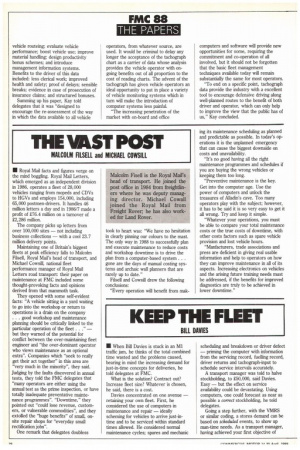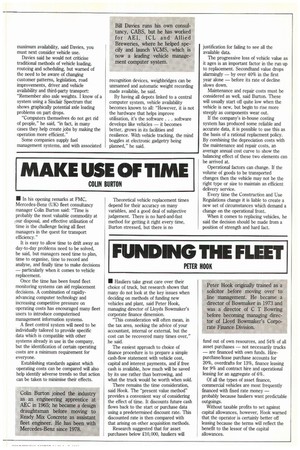KEEP THE FLEET
Page 40

Page 41

If you've noticed an error in this article please click here to report it so we can fix it.
BILL DAVIES
• When Bill Davies is stuck in an M1 traffic jam, he thinks of the total combined time wasted and the problems caused, bearing in mind the increasing demand for just-in-time concepts for deliveries, he told delegates at FMC.
What is the solution? Contract out? Increase fleet size? Whatever is chosen, he said, there is a cost.
Davies concentrated on one avenue — retaining your own fleet. First, he considered the use of computers in maintenance and repair — ideally scheming for vehicles to arrive just-intime and to be serviced within standard times allowed. He considered normal maintenance cycles; spares and mechanic scheduling and breakdown or driver defect — priming the computer with information from the servicing record, fuelling record, driver returns and tachograph-input to schedule service intervals accurately.
A transport manager was told to halve stockholding, to £50,000, said Davies. Easy — but the effect on service availability could be devastating. Using computers, one could forecast as near as possible a correct stockholding, he told delegates.
Going a step further, with the VMRS or similar coding, a stores demand can be based on scheduled events, to show up man-time needs. As a transport manager, having achieved your first objective of maximum availability, said Davies, you must next consider vehicle use.
Davies said he would not criticise traditional methods of vehicle loading, routeing and scheduling, but warned of the need to be aware of changing customer patterns, legislation, road improvements, driver and vehicle availability and third-party transport: "Remember also axle weights. I know of a system using a Sinclair Spectrum that shows graphically potential axle loading problems on part drops.
"Computers themselves do not get rid of people," he said, "in fact, in many cases they help create jobs by making the operation more efficient."
Some companies supply fuel management systems, and with associated recognition devices, weighbridges can be unmanned and automatic weight recording made available, he said.
By having all depots linked to a central computer system, vehicle availability becomes known to all: "However, it is not the hardware that helps improve utilisation, it's the software. . . software develops like vehicles — it becomes better, grows in its facilities and resilience. With vehicle tracking, the mind boggles at electronic gadgetry being planned," he said.












































































































